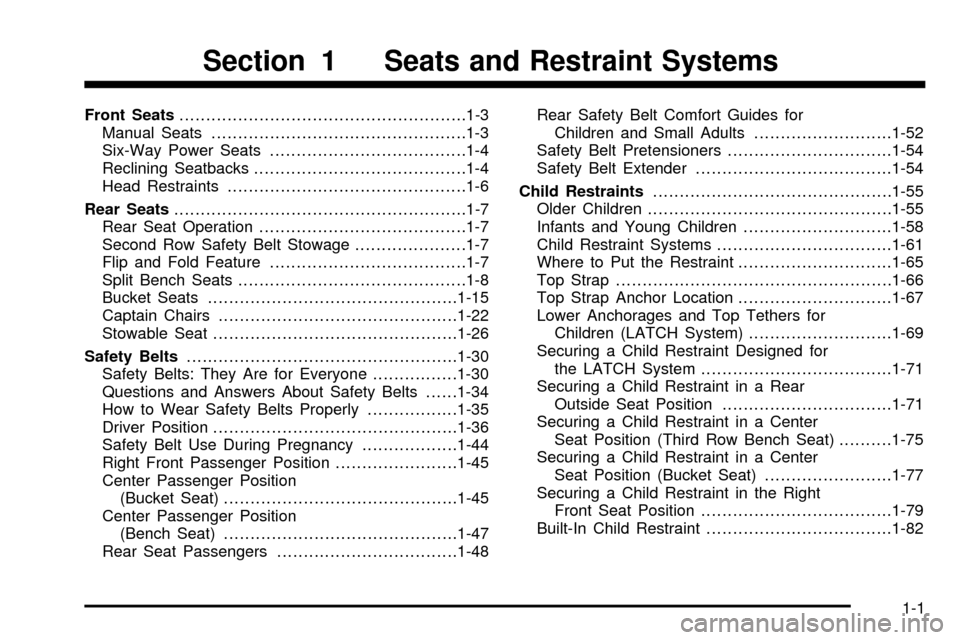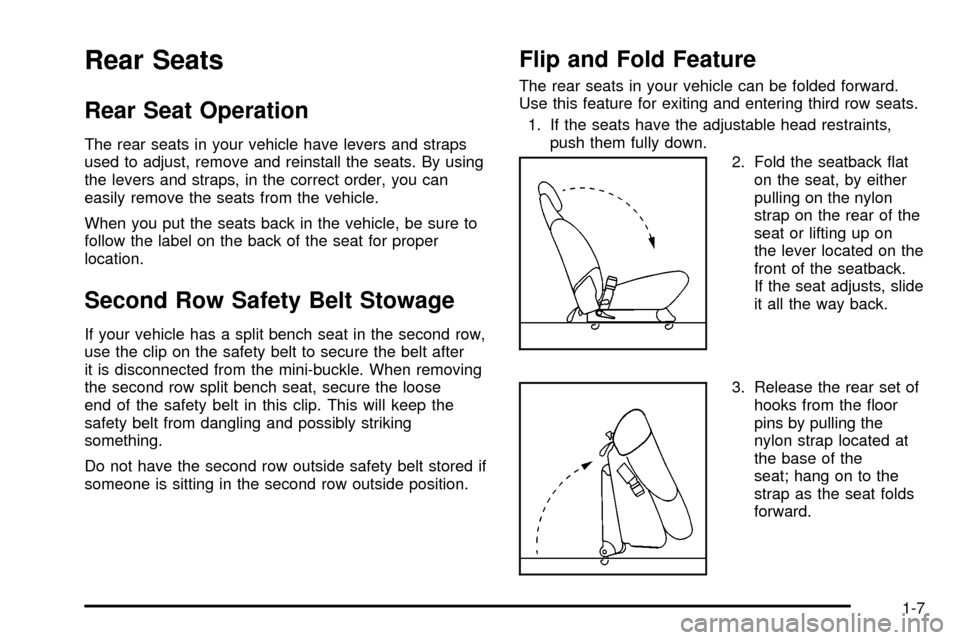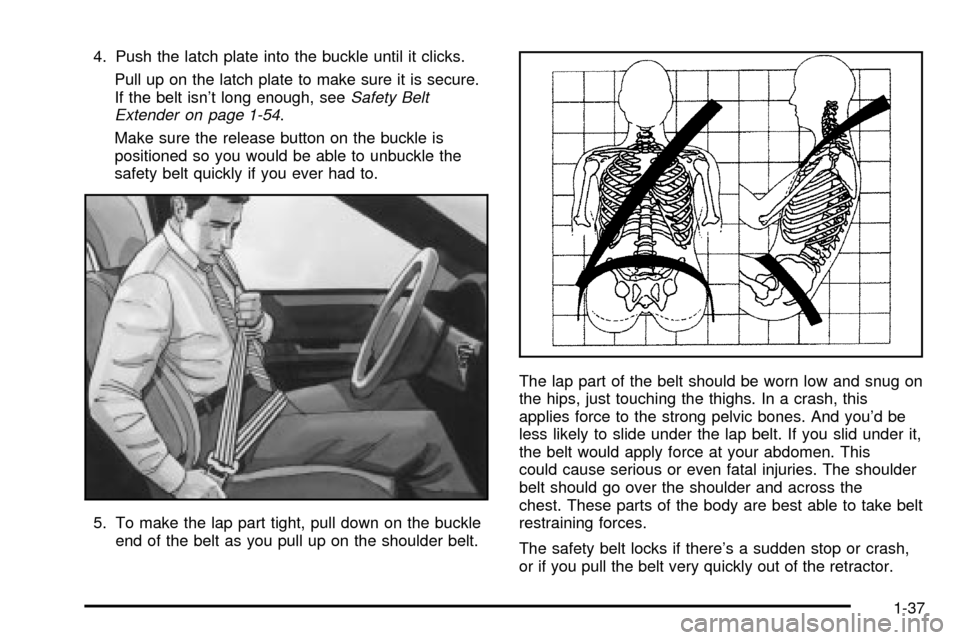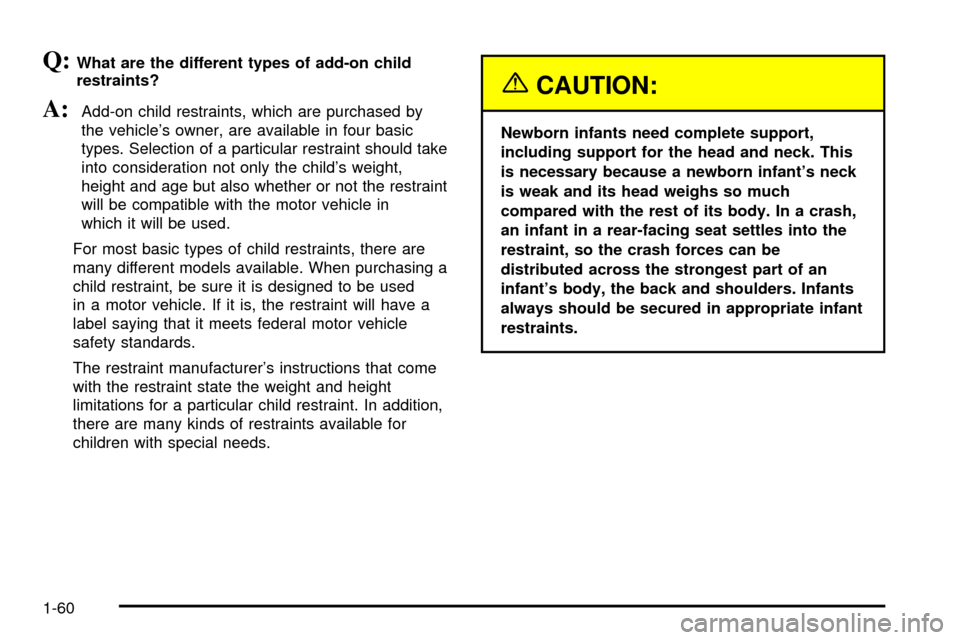Page 7 of 486

Front Seats......................................................1-3
Manual Seats................................................1-3
Six-Way Power Seats.....................................1-4
Reclining Seatbacks........................................1-4
Head Restraints.............................................1-6
Rear Seats.......................................................1-7
Rear Seat Operation.......................................1-7
Second Row Safety Belt Stowage.....................1-7
Flip and Fold Feature.....................................1-7
Split Bench Seats...........................................1-8
Bucket Seats...............................................1-15
Captain Chairs.............................................1-22
Stowable Seat..............................................1-26
Safety Belts...................................................1-30
Safety Belts: They Are for Everyone................1-30
Questions and Answers About Safety Belts......1-34
How to Wear Safety Belts Properly.................1-35
Driver Position..............................................1-36
Safety Belt Use During Pregnancy..................1-44
Right Front Passenger Position.......................1-45
Center Passenger Position
(Bucket Seat)............................................1-45
Center Passenger Position
(Bench Seat)............................................1-47
Rear Seat Passengers..................................1-48Rear Safety Belt Comfort Guides for
Children and Small Adults..........................1-52
Safety Belt Pretensioners...............................1-54
Safety Belt Extender.....................................1-54
Child Restraints.............................................1-55
Older Children..............................................1-55
Infants and Young Children............................1-58
Child Restraint Systems.................................1-61
Where to Put the Restraint.............................1-65
Top Strap....................................................1-66
Top Strap Anchor Location.............................1-67
Lower Anchorages and Top Tethers for
Children (LATCH System)...........................1-69
Securing a Child Restraint Designed for
the LATCH System....................................1-71
Securing a Child Restraint in a Rear
Outside Seat Position................................1-71
Securing a Child Restraint in a Center
Seat Position (Third Row Bench Seat)..........1-75
Securing a Child Restraint in a Center
Seat Position (Bucket Seat)........................1-77
Securing a Child Restraint in the Right
Front Seat Position....................................1-79
Built-In Child Restraint...................................1-82
Section 1 Seats and Restraint Systems
1-1
Page 13 of 486

Rear Seats
Rear Seat Operation
The rear seats in your vehicle have levers and straps
used to adjust, remove and reinstall the seats. By using
the levers and straps, in the correct order, you can
easily remove the seats from the vehicle.
When you put the seats back in the vehicle, be sure to
follow the label on the back of the seat for proper
location.
Second Row Safety Belt Stowage
If your vehicle has a split bench seat in the second row,
use the clip on the safety belt to secure the belt after
it is disconnected from the mini-buckle. When removing
the second row split bench seat, secure the loose
end of the safety belt in this clip. This will keep the
safety belt from dangling and possibly striking
something.
Do not have the second row outside safety belt stored if
someone is sitting in the second row outside position.
Flip and Fold Feature
The rear seats in your vehicle can be folded forward.
Use this feature for exiting and entering third row seats.
1. If the seats have the adjustable head restraints,
push them fully down.
2. Fold the seatback ¯at
on the seat, by either
pulling on the nylon
strap on the rear of the
seat or lifting up on
the lever located on the
front of the seatback.
If the seat adjusts, slide
it all the way back.
3. Release the rear set of
hooks from the ¯oor
pins by pulling the
nylon strap located at
the base of the
seat; hang on to the
strap as the seat folds
forward.
1-7
Page 43 of 486

4. Push the latch plate into the buckle until it clicks.
Pull up on the latch plate to make sure it is secure.
If the belt isn't long enough, see
Safety Belt
Extender on page 1-54.
Make sure the release button on the buckle is
positioned so you would be able to unbuckle the
safety belt quickly if you ever had to.
5. To make the lap part tight, pull down on the buckle
end of the belt as you pull up on the shoulder belt.The lap part of the belt should be worn low and snug on
the hips, just touching the thighs. In a crash, this
applies force to the strong pelvic bones. And you'd be
less likely to slide under the lap belt. If you slid under it,
the belt would apply force at your abdomen. This
could cause serious or even fatal injuries. The shoulder
belt should go over the shoulder and across the
chest. These parts of the body are best able to take belt
restraining forces.
The safety belt locks if there's a sudden stop or crash,
or if you pull the belt very quickly out of the retractor.
1-37
Page 52 of 486
Lap Belt
If your vehicle has bucket seats, someone can sit in the
center position bucket seat.
When you sit in the center position bucket seat, you
have a lap safety belt which has a retractor.
1. Pick up the latch plate and, in a single motion, pull
the belt across you. Don't let it get twisted.2. Push the latch plate into the buckle until it clicks. If
the belt stops before it reaches the buckle, let it go
back all the way and start again. Pull up on the
latch plate to make sure it is secure.
3. Feed the lap belt into the retractor to tighten it.
4. Position and release it the same way as the lap
part of a lap-shoulder belt.
If the belt isn't long enough, see
Safety Belt
Extender on page 1-54.
1-46
Page 56 of 486
Pull up on the latch plate to make sure it is secure.
When the shoulder belt is pulled out all the way,
it will lock. If it does, let it go back all the way and
start again.
If the belt is not long enough, see
Safety Belt
Extender on page 1-54.
Make sure the release button on the buckle is
positioned so you would be able to unbuckle the
safety belt quickly if you ever had to.3. To make the lap part tight, pull down on the buckle
end of the belt as you pull up on the shoulder part. Third Row Outside Passenger Position
1-50
Page 65 of 486
CAUTION: (Continued)
it. For example, in a crash at only 25 mph
(40 km/h), a 12-lb. (5.5 kg) baby will suddenly
become a 240-lb. (110 kg) force on a person's
arms. A baby should be secured in an
appropriate restraint.
{CAUTION:
Children who are up against, or very close to,
any air bag when it in¯ates can be seriously
injured or killed. Air bags plus lap-shoulder
belts offer outstanding protection for adults
and older children, but not for young children
and infants. Neither the vehicle's safety belt
system nor its air bag system is designed for
them. Young children and infants need the
protection that a child restraint system can
provide.
1-59
Page 66 of 486

Q:What are the different types of add-on child
restraints?
A:Add-on child restraints, which are purchased by
the vehicle's owner, are available in four basic
types. Selection of a particular restraint should take
into consideration not only the child's weight,
height and age but also whether or not the restraint
will be compatible with the motor vehicle in
which it will be used.
For most basic types of child restraints, there are
many different models available. When purchasing a
child restraint, be sure it is designed to be used
in a motor vehicle. If it is, the restraint will have a
label saying that it meets federal motor vehicle
safety standards.
The restraint manufacturer's instructions that come
with the restraint state the weight and height
limitations for a particular child restraint. In addition,
there are many kinds of restraints available for
children with special needs.
{CAUTION:
Newborn infants need complete support,
including support for the head and neck. This
is necessary because a newborn infant's neck
is weak and its head weighs so much
compared with the rest of its body. In a crash,
an infant in a rear-facing seat settles into the
restraint, so the crash forces can be
distributed across the strongest part of an
infant's body, the back and shoulders. Infants
always should be secured in appropriate infant
restraints.
1-60
Page 67 of 486
{CAUTION:
The body structure of a young child is quite
unlike that of an adult or older child, for whom
the safety belts are designed. A young child's
hip bones are still so small that the vehicle's
regular safety belt may not remain low on the
hip bones, as it should. Instead, it may settle
up around the child's abdomen. In a crash, the
belt would apply force on a body area that's
unprotected by any bony structure. This alone
could cause serious or fatal injuries. Young
children always should be secured in
appropriate child restraints.
Child Restraint Systems
An infant car bed (A), a special bed made for use in a
motor vehicle, is an infant restraint system designed
to restrain or position a child on a continuous ¯at
surface. Make sure that the infant's head rests toward
the center of the vehicle.
1-61